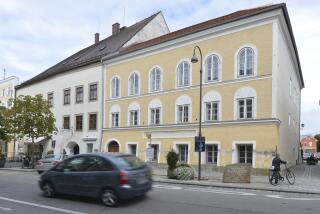Getting at the Heart of Berlin
- Share via
BERLIN — Before East German Communist leader Walter Ulbricht blew it up 51 years ago, the Berlin Palace was the architectural signature of this city for 250 years, and the adjacent Palace Square was the bustling heart of the Prussian Empire.
Now, the priceless central real estate yawns wastefully empty but for illegally parked cars, an abandoned and asbestos-laden Communist-era culture center and another shoddy postwar building about to be closed for renovation.
But a committee of architects, art historians, politicians and preservationists embarks today on a yearlong mission to determine whether Ulbricht should have the last word on how the capital’s historic center presents itself to the world.
In this 300th anniversary year of the House of Hohenzollern, the dynasty that expanded and ruled Prussia until its defeat in World War I, Germans are trying to find the proper place for that era of their history and the best use for the property the royal house once occupied.
The 17-member expert committee is both made up of and besieged by champions of the various proposals competing for Parliament’s eventual approval.
The most popular idea, according to a poll late last year by the Forsa research institute, is reconstruction of the original palace, which was completed by architect Andreas Schlueter in the early 18th century. That project was supported by 36% of those polled. On the other hand, 29% in this city divided by the Berlin Wall until 11 years ago want to shore up the Communist-era Palace of the Republic, an unsightly culture center replete with asbestos and oxidized mirrored panels that many eastern Germans nonetheless regard with nostalgia. Only 8% support using the square to build a modern structure, while 23% would prefer to see the area supplanted by a park.
The committee has set hearings for April to get citizen comments on the proposals. Once the general use is determined and a financing package put together, the experts plan an architectural competition leading to a presentation to Parliament of a building plan by the end of the year.
Although the tasks seem straightforward, they are complicated by a coinciding debate over the degree to which the Prussian monarchy provided the militarist material with which Adolf Hitler built the Third Reich. Those pushing for reconstruction of the sprawling palace are being confronted with accusations that they want to flex reunified Germany’s political muscle.
“It’s absurd to see this as the restoration of a Prussian symbol,” says Wilhelm von Boddien, a committee member and former advisor on Berlin’s urban planning. “Reconstruction of the palace would restore some continuity to Berlin, which has no historical or political center. With the destruction of the palace, the whole city was broken into fragments.”
Von Boddien notes that the Brandenburg Gate has become the de facto symbol of the German capital. “It was never meant to be a national monument--it was the entrance to the palace,” he notes.
Like most engaged in preparing the comeback of Berlin’s central square, Von Boddien believes that the Palace of the Republic, only 25 years old but crumbling, will be torn down as nostalgia for it subsides.
But among the activists deciding the square’s fate, there are many who argue for replacing the old structures and ruins with a thoroughly new and unifying concept.
“We need a fascinating new idea that will allow us to escape all these backward-looking proposals,” says Klaus-Dieter Lehmann, president of the Prussian Cultural Heritage Foundation.
Lehmann wants to house the Ethnographic Museum treasures now exiled in the remote suburb of Dahlem in whatever structure emerges on the site. Central prominence for the Continent’s largest collection of Asian, African and Latin American artifacts would diversify what he sees as the Eurocentric face of Berlin’s main museums.
As Germans weigh the Prussian qualities that are still respected today--duty, community service, industriousness and order--against the “blood and iron” power politics of the fallen monarchy, Lehmann says this year of the Hohenzollern jubilee and urban-planning juries presents “a unique chance to clarify what Prussia stood for.”
More to Read
The biggest entertainment stories
Get our big stories about Hollywood, film, television, music, arts, culture and more right in your inbox as soon as they publish.
You may occasionally receive promotional content from the Los Angeles Times.











